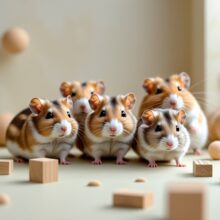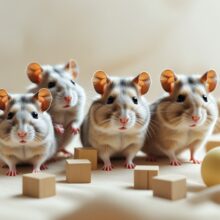Gerbil Toys and Enrichment

Gerbil Toys and Enrichment: Keeping Your Gerbils Happy and Healthy
Gerbils are active, curious, and intelligent animals that require a stimulating environment to thrive. Providing a variety of toys and enrichment activities is essential for their physical and mental well-being. This comprehensive guide will cover everything you need to know about gerbil toys and enrichment, including the types of toys, how to create an engaging habitat, and tips for keeping your gerbils entertained and happy.
Importance of Toys and Enrichment
Toys and enrichment are crucial for gerbils for several reasons:
- Physical Exercise: Toys and activities encourage physical exercise, helping to maintain a healthy weight and prevent obesity.
- Mental Stimulation: Engaging toys and activities stimulate gerbils’ minds, preventing boredom and promoting cognitive development.
- Natural Behaviors: Enrichment items allow gerbils to express natural behaviors such as digging, gnawing, and foraging.
- Stress Reduction: A stimulating environment reduces stress and anxiety, leading to happier and healthier gerbils.
Types of Gerbil Toys
There are various types of toys that cater to different aspects of gerbil behavior and enrichment needs. Here are some essential toys for gerbils:
- Chew Toys
Chew toys are essential for gerbils, as their teeth grow continuously throughout their lives. Providing chew toys helps keep their teeth trimmed and healthy.
- Wooden Chews: Natural, untreated wooden chews are ideal for gnawing. Popular options include applewood sticks, willow branches, and coconut shells.
- Cardboard Tubes: Simple cardboard tubes from paper towel rolls or toilet paper rolls make excellent chew toys. They are safe, inexpensive, and can be easily replaced.
- Commercial Chew Toys: Various commercial chew toys are available, made from safe materials like wood, pumice, or mineral blocks. These toys are designed specifically for small animals and are widely available in pet stores.
- Exercise Wheels
Exercise wheels provide essential physical activity for gerbils. They love to run and explore, and a wheel allows them to do so within the confines of their cage.
- Solid Surface Wheels: Choose an exercise wheel with a solid running surface to prevent injuries. Avoid wire or mesh wheels, as they can cause foot injuries.
- Size: Ensure the wheel is large enough for your gerbil to run comfortably without arching its back. A wheel with a diameter of at least 8 inches is recommended.
- Silent Wheels: Consider investing in a silent wheel to minimize noise, especially if the cage is in a bedroom or living area.
- Tunnels and Hideouts
Tunnels and hideouts provide gerbils with opportunities for exploration, nesting, and hiding. These items mimic their natural burrowing behavior and create a sense of security.
- Plastic Tunnels: Commercial plastic tunnels are durable and easy to clean. They come in various shapes and sizes, allowing you to create a complex tunnel system.
- Cardboard Tunnels: Cardboard tubes and boxes make great tunnels and hideouts. They are inexpensive and can be easily replaced when worn out.
- Wooden Houses: Small wooden houses or huts provide cozy hideouts for gerbils to rest and sleep. Ensure the wood is untreated and safe for gnawing.
- Climbing Structures
Climbing structures encourage physical activity and provide mental stimulation. Gerbils enjoy climbing and exploring different levels in their cage.
- Branches and Ladders: Natural branches and wooden ladders are excellent climbing structures. Ensure they are securely attached and stable to prevent accidents.
- Platforms and Shelves: Adding platforms and shelves to the cage creates additional levels for your gerbils to explore. These can be made from wood, plastic, or other safe materials.
- Foraging Toys
Foraging toys encourage natural foraging behavior, providing mental stimulation and preventing boredom. These toys require gerbils to work for their food, mimicking their natural feeding habits.
- Food Dispensers: Food-dispensing toys release small amounts of food when manipulated. These toys challenge gerbils to figure out how to access the food, providing both mental and physical exercise.
- Puzzle Feeders: Puzzle feeders require gerbils to solve a puzzle or navigate a maze to access their food. These toys promote problem-solving skills and keep gerbils engaged.
Creating an Engaging Habitat
An engaging habitat is essential for keeping your gerbils happy and healthy. Here are some tips for creating a stimulating environment:
- Spacious Cage
Provide a spacious cage with plenty of room for exploration and enrichment. A larger cage allows for more toys and activities, reducing boredom and encouraging natural behaviors.
- Varied Enrichment Items
Include a variety of enrichment items in the cage to keep your gerbils entertained. Rotate toys regularly to maintain their interest and prevent boredom.
- Natural Materials
Use natural materials like wood, hay, and cardboard to create a more enriching and comfortable environment. These materials are safe for gnawing and provide a more natural habitat for your gerbils.
- Interactive Play
Engage in interactive play sessions with your gerbils outside the cage. Use your hands, toys, and treats to interact with your gerbils and provide additional mental and physical stimulation.
DIY Gerbil Toys and Enrichment
Creating DIY toys and enrichment items is a fun and cost-effective way to keep your gerbils entertained. Here are some simple DIY ideas:
- Cardboard Mazes
Create a maze using cardboard boxes and tubes. Cut out entrances and exits to form a complex maze for your gerbils to explore. This provides mental stimulation and encourages natural foraging behavior.
- Hanging Toys
Make hanging toys using pieces of untreated wood, string, and cardboard. Hang these toys from the top of the cage to encourage climbing and gnawing.
- Treat Rolls
Fill cardboard tubes with hay, treats, and shredded paper. Seal the ends with more paper or hay, creating a foraging toy that challenges your gerbils to work for their treats.
- Digging Box
Create a digging box using a shallow container filled with safe, dust-free sand or soil. Gerbils love to dig and burrow, and a digging box provides an additional outlet for this natural behavior.
Safety Considerations
When selecting and creating toys and enrichment items, safety should always be a priority. Here are some safety tips to keep in mind:
- Avoid Toxic Materials: Ensure all toys and materials are non-toxic and safe for gnawing. Avoid painted or treated wood, as well as plastics that can be easily chewed and ingested.
- Check for Sharp Edges: Inspect toys and enrichment items for any sharp edges or small parts that could cause injury or be swallowed.
- Supervise New Toys: When introducing new toys or enrichment items, supervise your gerbils to ensure they are using them safely.
- Maintain Cleanliness: Regularly clean and replace toys to prevent the buildup of dirt and bacteria. Ensure food-dispensing toys and foraging items are free from mold or spoilage.
Conclusion
Providing a variety of toys and enrichment activities is essential for keeping your gerbils happy, healthy, and engaged. By understanding their natural behaviors and needs, you can create a stimulating environment that promotes physical and mental well-being. Whether you choose commercial toys or create your own DIY enrichment items, the key is to offer a diverse and ever-changing array of activities that keep your gerbils entertained and enriched. With the right toys and environment, your gerbils will thrive and bring joy and companionship to your life.



